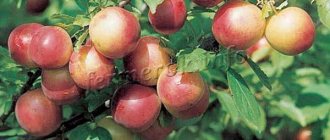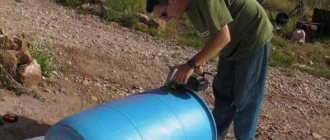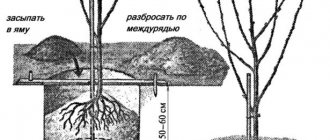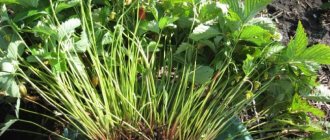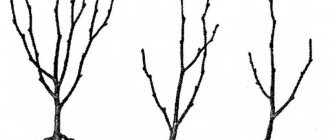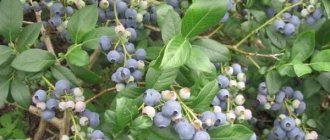A little about culture...
The sea buckthorn tree is a fairly common plant in our country. Large thickets of the culture are found in Central Asia and the Caucasus, Altai and the Baltic states, as well as in Eastern and Western Siberia. Since ancient times, sea buckthorn fruits have been used in processed and fresh forms.
Sea buckthorn began to be propagated as an ornamental crop 150 years ago. The breeding of industrial varieties was carried out at the Horticulture Research Institute named after. Lisavenko M.A., in which several quite promising species were obtained. Particular interest in sea buckthorn began to be shown in recent decades, when the beneficial properties of the fruit were identified.
Sea buckthorn began to be spread in the Moscow region in the forties. It appeared in the region thanks to an employee of the Botanical Garden of Moscow State University T.T. Trofimov. Currently, the culture has become incredibly widespread in the Moscow region. In order to successfully grow a plant and get a harvest, you need to know some of the features of planting sea buckthorn and caring for it.
Popular varieties
Apple tree (tree)
Breeders have developed several hundred varieties of sea buckthorn. Among the most famous:
- Moscow beauty is characterized by a high level of productivity. From one bush you can get up to 16 kg of berries, which ripen in early autumn.
- Golden cob. The fruiting period begins after 3 years. There are practically no thorns on the branches. The advantage is that the variety has excellent winter hardiness. This allows you to grow Golden Cob even in the Urals. The fruits will ripen at the end of summer.
- Golden Siberia. The main characteristics of this variety are considered to be high yield (up to 21 kg of fruit per plant) and frost resistance. This thorny shrub can grow in the Krasnodar Territory, Crimea, as well as in the Leningrad Region, where winters are harsh or have little snow. Full ripeness of the berries occurs in early autumn.
- Buckthorn. There are no thorns on the branches of the bush. The weight of the fruit reaches 10 g. They ripen by the end of summer. The peculiarity of the variety is its drought and frost resistance.
- Nizhny Novgorod beauty. The variety was recently released. The berries can ripen already in mid-summer.
golden cob
Each of them has its own characteristics that must be taken into account when growing.
The value of sea buckthorn
The popularity of the culture is associated with its incredible beneficial properties. Few people know how sea buckthorn blooms, but everyone knows what its fruits look like. Small bright berries contain vitamins B, P, B2, E, B, C and carotene (provitamin A). In addition, the fruits are rich in manganese, iron, boron, magnesium, sulfur, aluminum, titanium and silicon. Externally, they are a juicy drupe, sweet and sour or sour in taste, enriched with acids. The acid content of different varieties, naturally, is different; this indicator ranges from one to four percent. But the sugar content is in the range of 1.6 – 6.4%. However, it is worth noting that not only the fruits of the crop are endowed by nature with a large number of useful substances. Sea buckthorn leaves, for example, contain a lot of vitamins C and A. As the bright fruits ripen, the number of vitamins in the foliage decreases sharply.
Speaking about the beneficial properties of the crop, it is worth remembering sea buckthorn oil, which is richer than all known vegetable oils in terms of the amount of biologically active substances it contains. It is actively used in the treatment of a variety of ailments, it is especially effective for problems with the skin - frostbite, burns, radiation injuries.
Sea buckthorn has long been used in folk medicine to treat rheumatism and gastrointestinal problems.
Types of sea buckthorn
Sea buckthorn is a genus of plants in the Sucker family. It grows in the form of shrubs or trees, mostly thorny. Scientists distinguish 3 types of sea buckthorn:
- looseleaf,
- buckthorn,
- Tibetan.
The willow-leaved species of sea buckthorn grows in the Himalayas, China, in the mountainous regions of India, and Nepal. Tall trees with branches hanging down like a willow are extremely rare in Russia. The fruits of this sea buckthorn are yellow, about 6 mm in diameter.
Sea buckthorn got its name because of its drooping branches.
Sea buckthorn grows in Europe, Asia, the North Caucasus, and Crimea. It is a shrub with a height of 1 to 3 m. It is widely cultivated as a fruit crop, and is also used as an element of garden design to create hedges. Distinctive features are small silver-green leaves and rounded yellow or orange fruits.
On the territory of Russia you can most often find sea buckthorn
They first learned about Tibetan sea buckthorn in Russia in the 19th century from the writings of N.M. Przhevalsky traveling through Central Asia. This species grows in the highlands of India, Nepal, on the southern slopes of the Himalayas and in the mountainous regions of China. The height of the bush with a winding trunk and numerous thorny branches does not exceed 80 cm. But the berries are very large compared to other species - 11 mm in length and 9 mm in diameter.
Tibetan sea buckthorn is small in size - the height of the bushes does not exceed 80 cm
When and how does sea buckthorn bloom?
However, it has one peculiarity. In nature, there are male and female plants. But how to distinguish male and female sea buckthorn is a question that invariably interests all gardeners who intend to get a harvest. If you plant same-sex trees on your plot, you will not be able to get fruit from them. The thing is that the crop is wind-pollinated, although sometimes there are species with bisexual flowers.
In order to plant seedlings of both sexes, you need to understand how to distinguish male from female sea buckthorn. Unfortunately for gardeners, it is almost impossible to find differences in the early stages. They become a little noticeable from the moment the flower buds are laid. On male sea buckthorn they are much larger than on female ones. An interesting fact is that they are laid on two-year-old shoots. Few people know how sea buckthorn blooms. This is due to the fact that the flowers of the culture are completely inconspicuous, so against the background of fragrant apple trees, peaches and cherries, no one notices them.
Trees bloom in May or April. Flowers appear along with foliage. However, on bushes of different sexes they have different colors. On female sea buckthorn they are yellowish, but on male sea buckthorn they are silvery-brown. The inflorescences cannot be called beautiful. Sea buckthorn flowers blend in slightly with the foliage and are therefore hardly noticeable.
How to choose sea buckthorn seedlings
It is better to select and plant sea buckthorn seedlings in early spring. Then over the summer the tree will take root well and overwinter normally. Seedlings two years old are suitable for planting.
Selection of seedlings
- It is important to ensure that the seedlings are healthy and appropriate for the plant variety. A two-year-old seedling has a height of about 50 cm and a diameter of 5–7 cm; it also has 5–8 skeletal roots, 25 cm long.
- The bark adheres tightly to the wood, has a healthy appearance, is not wrinkled or scratched.
To avoid tree diseases, you should not plant raspberries, strawberries, or where stone fruit trees grew: apple trees, pears, cherries, apricots.
It is better to have 2-3 female trees and one male tree on the site for pollination.
Planting sea buckthorn
Sea buckthorn is planted in spring and autumn. As a rule, plants planted in the spring take root much better because they are not threatened by winter temperature changes. For a young seedling, both excessive heat and cold can be very harmful.
Proper planting of sea buckthorn in the spring is the key to the fact that the plant will certainly take root. However, it is worth deciding on the variety in advance; it must be adapted to the conditions of your region. It is better to purchase seedlings from trusted nurseries rather than from markets. This way you can be sure that you purchased the plant of the exact variety you chose.
For sea buckthorn, you need to choose the right place on your site. Preference should be given to quiet areas away from active gardening activities. This is due to the fact that the plant has cord-like roots located in the upper layers of the soil. To avoid injury during digging, it is worth planting the crop in quiet places. However, it is worth remembering that sea buckthorn loves unshaded, bright places.
Starting in the fall, you can prepare a place for planting. To do this, add sand and humus to the soil in equal proportions, and phosphorus-potassium additives will not hurt. The distance between trees should be at least several meters. If you plan to get a harvest, then you need to plant at least 3-4 plants. For five female cultures, one male culture is sufficient.
The process of planting a tree or bush is not difficult. A hole of 70*70*70 centimeters is prepared, at the bottom of which you need to make a mound, along the slopes of which you need to spread the roots. Then the hole is filled with soil slightly above the root collar. You definitely need to form a hole around the seedling to water it. Two buckets of water will be enough for watering.
Caring for sea buckthorn seedlings after planting
Sea buckthorn can rightly be called a very unpretentious plant. If you initially choose the right place and plant it in open ground, then there should be no problems with growing it. However, in the first time after the autumn procedure, you need to pay attention to the shrub and properly care for it.
Features of caring for sea buckthorn after planting in the fall:
- Immediately after planting, you need to draw up a tree trunk circle . To do this, you just need to make a roller of earth around the trunk at a distance of about 50 centimeters.
- Then you need to water the seedling abundantly , pouring water into the circle around the trunk. You will need about 3-4 buckets for one tree. Without life-giving moisture, the seedling will not take root.
- If some time after planting the ground settles, then you need to fill the soil to the previous level .
- If, after watering, the seedling is buried deep and its root collar is underground, then you need to carefully lift it by the trunk and once again compact the soil around it with your hand or foot.
- Mulch the tree trunk using, for example, lowland peat, rotted sawdust, rotted compost. The optimal mulch height is 7-10 centimeters. Mulch will not only slow down the evaporation of moisture, which is necessary for comfortable rooting and adaptation, but will also protect the root system of the seedling from winter frosts.
- A very important point in care after planting is preparing young sea buckthorn for winter. In addition to mulching, you need to provide shelter. However, in the southern regions there is no need to cover.
Cultivation care
A description of sea buckthorn would be incomplete without saying a few words about how it should be cared for. Young seedlings need regular watering, since the crop is moisture-loving. Once the plant gets stronger, the frequency of watering can be reduced. Experienced gardeners do not recommend fertilizing the tree trunk because of the cord-like root system. But after the sea buckthorn blooms and the fruits appear, the plant can be fed with mineral and organic fertilizers. This is done no more than once every three years.
Plant care also includes removing weeds. However, this must be done carefully so as not to damage the root system. The formation of the crown and pruning of trees should be done in the spring before the buds open. Blooming sea buckthorn should never be injured. After reaching 8 years, the plant needs to be pruned regularly for the purpose of rejuvenation. To do this, remove old shoots and leave three-year-old ones. In addition, you should definitely remove frozen and diseased areas of branches.
Don't forget about watering mature trees. Sometimes during dry periods, even strong plants can dry out or lose their harvest.
Principles of growing and caring for sea buckthorn
Sea buckthorn is a low deciduous thorny shrub or tree of the sucker family. It is found quite often in the wild, especially in Siberia. Prefers light sandy and pebble soils, grows along streams and river banks.
You can plant sea buckthorn in your dacha both for decorative purposes and to obtain a harvest of berries. This plant is quite resistant to various diseases and pests. The agricultural technology for growing sea buckthorn is not particularly complicated. Of the mandatory procedures, only pruning is carried out, which is done to form a healthy tree or shrub, as well as for sanitary purposes.
How to choose a variety for the Moscow region?
Thanks to the hard work of breeders, it is now possible to select a variety for cultivation in almost any region of the country. The plant bears fruit well in the climatic conditions of Central Russia, which means you can choose a suitable variety of sea buckthorn for the Moscow region. In order to understand which variety to give priority to, you need to know what parameters are important to you: yield, ripening time, taste, winter hardiness, fruit size, degree of oil concentration, content of nutrients, absence of thorns and thorns.
Experienced gardeners recommend paying attention to the following promising varieties for the Moscow region:
- Lomonosovskaya. This is a medium-sized tree with a small number of spines. The red-orange fruits have an elongated shape and a sweet and sour taste.
- Fragrant. Medium-sized plant with high yield. The pulp of the fruit has a characteristic pineapple aroma.
- Botanical amateur. Medium-sized tree with high yield and large orange berries.
- Botanical fragrant. A medium-sized tree with orange-red fruits can produce up to 14 kilograms of yield.
- Excellent. An early ripening variety with high yield.
How to plant sea buckthorn
When carrying out work, you need to follow some rules for planting sea buckthorn. Here's what you need to consider first:
- One male plant can pollinate 5–8 female ones. A larger number of fruit-bearing trees will only be partially pollinated. Therefore, to obtain a good harvest, bushes are usually planted in a group, surrounding the male plant with female plants in a ratio of no more than 1:5.
- Males die more often, so many gardeners increase their number relative to females for insurance.
- For planting, it is best to choose seedlings of the same variety.
- The root system of the shrub grows widely and is approximately twice the size of the crown.
- The roots of the plant are at a shallow depth. Therefore, no agricultural work is carried out within a radius of 2 m from the bush. Neighboring plants are planted at the same distance from each other.
When planting bushes for decorative purposes, gender issues can be neglected. The distance must be maintained so that the roots of neighboring plants do not oppress each other.
When is it better to plant sea buckthorn: in spring or autumn?
It is impossible to answer this question unequivocally. Most gardeners agree that it is correct to plant sea buckthorn in the spring. However, this is not quite true. The timing of excavation work depends on many factors. You can plant sea buckthorn on your site even in summer, if before that it had been growing in a tub for more than a year.
Autumn planting can be carried out if it is known for sure that the seedling grew in the same area. If it is from more southern regions, the plant may wake up from hibernation in January–February and is guaranteed to die. Planting sea buckthorn seedlings in spring allows you to minimize risks.
How to plant sea buckthorn in spring
It is best to plant sea buckthorn in the spring in late March or early April. During this period, the bushes are at rest, and the soil has a good supply of moisture.
Planting sea buckthorn in autumn
You can plant sea buckthorn in the fall if the root system of the seedlings is closed. The optimal planting time is late September - early October. By this time, the leaves from the tree, as a rule, fly off. Therefore, all the plant’s efforts will be aimed at taking root. A step-by-step guide on how to plant sea buckthorn in the fall is no different from the spring, and is given below.
If the deadlines are missed, the seedlings can be buried and, after wintering, planted in a permanent place. The seedlings are placed in a ditch 0.5 m deep so that the crown faces south. After covering the bushes with soil, they need to be watered well. With the onset of the first frost, they are almost completely covered with earth, leaving only the tops of the branches, and then covered with spruce branches on top. When snow falls, they fill up the shelter.
Important! When planting seedlings until spring, you need to make sure that their roots are not tangled with each other.
Where to plant sea buckthorn on the site
The place for planting sea buckthorn should be open and sunny. You should not place it next to garden beds, otherwise there is a high risk of damage to the roots when digging. The plant tolerates this very painfully. It is necessary to plant sea buckthorn at a distance from buildings and fences so as not to shade the bushes. This culture does not like being in close proximity to other trees, so, as a rule, it is given a place at the edge of the garden on the south side.
What kind of soil does sea buckthorn like?
Sea buckthorn prefers light sandy soils and black soil. Acidity is best neutral. The soil should be moist, but not swampy, therefore places with a groundwater level above 1 m are contraindicated for sea buckthorn.
How to choose sea buckthorn for planting
For planting to obtain a harvest, it is better to choose varietal sea buckthorn. This is especially true for female plants. Male ones may well be wild. Plants are planted as two-year-old seedlings. By this time, their height should be 0.35–0.5 m, and the roots should be at least 0.2 m long. There should be 2-3 main roots, a sufficient number of small ones.
When examining a seedling, you need to pay attention to the condition of the bark. Detachments are not allowed. The brown color indicates that the tree is freezing; the chances that such a seedling will take root are almost zero.
How to plant sea buckthorn in spring: step-by-step instructions
Sea buckthorn seedlings are planted in specially prepared holes. They dig them in advance so that the soil has time to infuse and be saturated with oxygen. In order to properly plant sea buckthorn in the spring, planting holes must be prepared in the fall; for autumn, at least a month in advance.
- When preparing holes, take into account the size of the root system of the seedling. Usually a depth of 0.5 m and the same diameter is sufficient.
- Stepping back a little from the center, you need to drive in a wooden support to which the tree will be tied.
- To the removed soil you need to add: humus - 1 bucket, river sand - 1 bucket, wood ash - 0.5 buckets, superphosphate - 0.2 kg.
- Mix all ingredients well.
- The seedling is placed in a planting hole so that the height of the root collar above ground level is 5–6 cm. The roots must be straightened and then covered with nutritious soil, lightly compacted to prevent the formation of voids.
- After planting, the tree must be tied to a support.
- The distance between seedlings when planting sea buckthorn in spring is at least 2 m.
Then the seedlings need to be watered abundantly, and the tree trunk circle should be mulched with sawdust, straw or grass.
A short educational video about planting sea buckthorn can be viewed at the link below.
What can be planted next to sea buckthorn
Only lawn grass can be planted under sea buckthorn. Nothing should be placed in the root system area (which is approximately two times the size of the tree crown). This is especially true for plants with a shallow root system (strawberries, currants); in competition for useful space, the aggressor sea buckthorn will simply strangle them. Therefore, next to the sea buckthorn, you can plant another tree of the same crop, but at a distance of at least 2–2.5 m, so that they do not conflict with each other.
Sea buckthorn propagation
Sea buckthorn is propagated in the following ways: seeds, layering and shoots. The seed method is completely ineffective, it is very labor-intensive, and the resulting plants do not inherit the necessary qualities of the mother tree.
But when propagated by shoots, young seedlings have the same characteristics as the main plant. For gardeners who have sea buckthorn in their garden, the most convenient way to obtain seedlings is the layering method. In spring, branches located close to the ground are covered with earth. Gradually, the buried shoots will give rise to roots. Next spring they can be dug up, cut off from the main plant and planted in a new place.
But still, the highest quality specimens for planting are obtained by cuttings. To do this, in mid-summer we cut branches, treat them with Kornevin, and then drop them into a damp substrate. Cover the top of the seedling with a disposable cup to create a mini-greenhouse. Cuttings must be regularly watered and ventilated. After eight weeks, the shelter over them can be removed and further cared for until spring. With the onset of warm weather, young seedlings are planted in a permanent place.
It is necessary to remember that sea buckthorn is a bisexual plant, and therefore male and female plants must grow in the same area, otherwise you will never see a harvest.
Among other things, sea buckthorn is grafted. On one tree you can graft female and male branches. Obtaining such a plant is a tempting idea, but not always feasible in real life. Grafted pagons do not always take root well; they gradually dry out without producing growth. But it's still worth experimenting.
Transplanting sea buckthorn in autumn
Earlier in the article it was already noted that sea buckthorn does not welcome transplants, so it is better to immediately plant it in the most suitable place. However, if there is still a need to replant the shrub, then you need to do it as correctly as possible.
First of all, you need to try to dig up the maximum number of roots . If some of the roots are damaged, then when replanting sea buckthorn in the fall, be sure to cut off the above-ground part . You need to trim all the side branches and the trunk, leaving about 1 meter. This pruning of the above-ground part will help the plant to more easily transfer the transplant to a new location. If this is not done, the shrub most likely will not take root.
Note! Transplantation to a new place must be done in the first 2-3 years of life. If you do this later, the tree most likely will not be able to survive the transplant.
Harvesting
Harvesting a large harvest of sea buckthorn is not an easy task. Labor-intensive work will require you to spend a sufficient amount of time. The berries of most varieties have very short stalks, and therefore picking the fruits is not easy. In addition, you need to work carefully, since overripe berries quickly wrinkle. Do not forget about sharp thorns that injure your hands.
Some gardeners recommend making the task easier by cutting off a third of the branches along with the harvest with pruning shears. Firstly, this makes picking berries much easier and faster in the future, and secondly, the branches can be stored in the room for a long time along with the fruits. No need to worry about cut pagons. In their place, new shoots will grow in the spring, which will bear fruit in two years. The tree does not suffer from this, because every year in the spring you still prune the old branches.
Why is it difficult to collect sea buckthorn?
Green woodpecker on sea buckthorn
This task is quite difficult; the process can be traumatic due to the sharp thorns that cover the branches. Sea buckthorn has fairly short stalks, and the ripe berries are soft to the touch and easily wrinkle under your fingers. Plus, the juice of the fruit is very acidic and can cause irritation to the skin of the hands with prolonged contact. What to do in this case?
There are radical methods in which the branches are cut off along with the fruits, but this is quite cruel to the tree. Experienced gardeners have found a way out of this situation. To begin with, before harvesting, put on clothes that you don’t mind getting dirty, which will inevitably happen. The second rule is that you need to collect fruits from the top of the branch towards the bottom.
How to collect sea buckthorn:
- The first method is a rough one, in which the branches with fruits are carefully cut off and immediately frozen. Frozen berries are easily removed from the branches, but this method is only suitable for those cases when you need them frozen.
- The second method is manual; cherries, cherries, apricots and other fruits are collected in the same way. It is traumatic, takes a lot of time, and requires increased attention.
- The third method is “skillful hands”, i.e. production of auxiliary devices. Gardeners use various tricks: they attach a sharp scraper to a long stick with electrical tape, which they use to scrape berries from the branches. Your assistant should stand below and hold either an open bag or an open umbrella for picking berries. Sometimes they use a knife with a long handle and collect the fruits using the same principle. However, the most convenient device is considered to be “cobra” - this is a popular name that has taken root among gardeners and summer residents. The device is a loop of dense wire that is securely attached to a long holder. You can drill two holes at the end of a round stick and thread a wire through them. For convenience, the loop itself is slightly bent so that when viewed from the side it resembles a cobra's hood. The top of the loop should be slightly narrowed. The place of fastening must be securely wrapped with wire or wrapped several times with insulating tape. Now you can quite conveniently cut the stalks with a “cobra”; you can open an umbrella from below where the berries will fall.
The “cobra” method of collecting sea buckthorn is the most acceptable and least traumatic.
A device for collecting sea buckthorn berries - a thin nylon rope is stretched between the slingshots
You can also wait until the first frosts, spread a cloth or a piece of polyethylene under the tree, then arm yourself with a heavy stick and attack the trunk and branches with it. From the impacts, frozen fruits will separate from the branches and fall onto the prepared blanket. Decide for yourself what is more convenient for you.
Watch a few videos, perhaps you will use ideas for picking berries with devices that are easy to make yourself, with your own hands.
Diseases to which the culture is susceptible
Previously, it was believed that sea buckthorn was completely immune to all kinds of diseases. However, the more widespread it became in our gardens, the more often gardeners began to notice that the crop is susceptible to all the same ailments as other garden trees: viral, fungal and bacterial.
The following diseases most often affect sea buckthorn:
- Endomycosis is a fungal disease that appears on fruits in early August, as a result of which they become flabby and filled with gray mucus. The integrity of the berries is compromised, liquid leaks out of them, which spreads endomycosis further. Treatment of the disease consists of treating (two-stage) wood with Bordeaux mixture (1%). The plant is treated for the first time immediately after flowering, and the second time in mid-July.
- Black cancer. The disease appears as black spots on large branches. In such places, the bark turns black and gradually falls off, and the wood rots. As a therapeutic measure for such a disease, damaged bark and affected wood are removed, after which fresh sections are treated with copper sulfate and a mixture of mullein and clay.
- Blackleg is caused by soil fungi. It only affects young seedlings. As a preventive measure, young plants should be watered with a solution of potassium permanganate.
- Scab is caused by fungi and affects fruits, leaves and young shoots, which leads not only to drying out of the branches, but also of the entire tree. If you notice black shiny spots on the berries in mid-summer, then this is scab. Gradually, the disease will spread to young branches. As a preventative measure, sanitary pruning of the tree should be carried out annually in the autumn, burning waste. In addition, 20 days before harvesting, sea buckthorn must be treated with Bordeaux mixture (1%).
- Brown and gray rot usually appears in July during the rainy season. Gray rot causes the berries to shrink, and brown rot causes dark spots to appear on the fruit. It is recommended to cut down and burn affected plants.
What diseases can attack sea buckthorn?
In the recent past, sea buckthorn was considered a crop that did not suffer from any diseases. However, with its cultivation in gardens, it turned out that, like other plants, it is susceptible to many diseases: fungal, viral, bacterial. The most common among them are:
Endomycosis. The disease appears on fruits in early August, and is provoked by a fungus. The berries are covered with gray mucus, they turn into flabby fruits. Fluid begins to leak out of them, transmitting the disease further. The disease is treated with 1% Bordeaux mixture in two stages. The first time the plant is treated is after flowering. Next time - in the second half of July.
Blackleg also refers to fungal diseases. It appears only on young seedlings. To protect seedlings from such a disease, they are watered with a solution of potassium permanganate.
Black cancer. Black spots form on large branches. The bark turns black and falls off over time. After which the tree in these places begins to rot. To cure a plant of this disease, rotten wood and damaged bark are removed, and the sections are treated with mullein with clay and copper sulfate.
Scab also comes from fungi. It settles on the leaves, fruits, and young shoots of the plant. After which, first the branches dry out, then the tree trunk. If you find shiny black spots on sea buckthorn fruits in mid-summer, keep in mind that this is scab. Over time, she will move to young shoots. For preventive purposes, the plant is sanitized every fall. The cut debris must be burned. Among other things, 3 weeks before harvest, the crop is treated with 1% Bordeaux mixture.
Gray and brown rot can occur on sea buckthorn in mid-summer during the rainy season. When gray rot appears, the berries shrivel. Brown rot appears as dark spots on the berries. There is no point in treating such plants. They should be cut down and burned.
Sea buckthorn pests
The most dangerous pests for trees are:
- Sea buckthorn moth. The caterpillars penetrate the swollen buds and destroy them from the inside. The most effective way to combat moths is to treat the crop with karbofos.
- The sea buckthorn fly can destroy the entire crop. Insects appear in mid-June. Fly larvae attack fruits from the inside. As a preventative measure, it is recommended to treat the tree with chlorophos in July.
- The sea buckthorn aphid feeds on the sap of leaves and young branches. Insects settle on the back side of the leaf blade, causing it to curl and turn yellow. Many gardeners use old folk methods in the fight against aphids, treating the tree with infusions of tobacco or onion peels. If such methods are ineffective, then you can use karbofos.
- The sea buckthorn mite is a very small insect that sucks the juice from the leaves, causing them to fall off. As methods for controlling mites, you can use the same solutions as for controlling aphids.
Flowering and fruiting of sea buckthorn
Both male and female sea buckthorn plants bloom. However, the purpose of these colors is different. Staminate (male) flowers produce pollen that pollinates female (pistillate) flowers. In place of the pollinated female flowers, fruits are set.
The ripening time of sea buckthorn greatly depends on the variety. The earliest berries can be picked in early August, the latest - in mid-September. A dry, hot summer will speed up ripening, while a cold and rainy summer will delay it.
When and how does sea buckthorn bloom (photo)
Both male and female bushes produce buds at approximately the same time. The very beginning of flowering strongly depends on weather conditions, for example, in central Russia, sea buckthorn blooms in the second ten days of May. This period lasts from one to two weeks. Flowering sea buckthorn (photo) - below.
Sea buckthorn flowers do not have nectaries, so they do not attract insects. This crop is pollinated only by the wind.
Important! Sometimes, in calm weather, the gardener himself has to work as a pollinator, cutting branches from a flowering male tree and fanning the female ones with them. Otherwise, pollination will not occur and there will be no harvest.
For what year after planting does sea buckthorn bear fruit?
After planting, sea buckthorn begins to bear fruit in the 4th year. Fruiting is considered full after 6 years of life. By this time, the tree is already fully formed and can spend all its vitality on the growth and ripening of berries.
Where to plant sea buckthorn on the site?
Sea buckthorn has some features of the root system that should be taken into account when choosing a planting site. Its roots grow in breadth, moving up to 5 m from the tree. But they do not lie deep at all - when digging up the soil they can be easily damaged.
Sea buckthorn is sensitive to root damage. That is why this plant should not be planted near garden beds - digging up the soil can damage the roots. Preference is given to the edges of the site - sea buckthorn is planted around the perimeter, where digging is not planned.
Planting Basics
The best time for planting is spring. How to plant sea buckthorn correctly? The seedlings are not placed closely, but leave enough distance so that a bush with a diameter of 2 m feels comfortable and free.
Planting must be done not one at a time, but always in groups. Among a group of female plants, there must be one male tree, which must be located on the windward side for successful pollination of female inflorescences by wind.
To plant a seedling, you need to dig a hole of sufficient width (depending on the size of the rhizome) and 50 cm deep. Sprinkle a mixture of lime and soil inside the hole.
Immerse the seedling in the hole:
- with a closed rhizome: up to the level of the earthen clod, leaving its upper part level with the ground,
- with an open rhizome: deepening the root neck by 10-15 cm, while the roots will grow in width.
